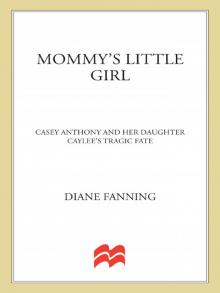- Home
- Diane Fanning
Sleep My Darlings Page 6
Sleep My Darlings Read online
Page 6
Another photo, showing all four members of the family donning Santa hats, generated another comment: “Your family is something to be proud of, look at how happy every one of you are!”
* * *
Beau had, in his easygoing fashion, made new friends from the moment he arrived in Tampa. He was passionate about playing soccer and was considered an “amazing goalkeeper.” He also played on Fusion, a football club team. He could often be seen playing basketball, street hockey, and other sports in the cul-de-sac with Scott Patchan, Calvin Works, and other neighborhood friends.
Like most boys his age, he also liked playing games on the Internet. One of his favorites was Call of Duty, a multiple-player modern warfare game. His list of gaming friends was long and international. One of them, an Ontario teenager, Abraham Nerajan, said, “I only knew him when we played online. But I know for a fact that he was an enthusiastic and generous kid.”
Beau attended nearby Liberty Middle School with its bright red tile entrance. Standing right next to it was the nearly identical Freedom High School—the two exteriors being so similar that at first glance they appeared to be one rambling school. Beau planned to shift next door to the other building when he went into ninth grade.
He was playful with his teachers at the middle school, teasing Ms. Daisy Questella about her chewing-gum rule, but he always did his homework and never got a bad grade. Beau was a good student but not as driven as his older sister. All in all, Beau settled into his life in Tampa with a broad network of friends at home and at school. He was spirited, full of fun—an all-American boy.
* * *
When Calyx first moved to Tampa, she was not as quick to get into her groove as Beau had been. She felt disconnected from her peers and not quite comfortable with social interactions with others her age. That changed when she entered into the esteemed International Baccalaureate Program at the C. Leon King High School.
The IB Program was an academically challenging and balanced education system designed to prepare students for success at university and life beyond. In addition to honors-level class instruction, the curriculum included three requirements to broaden the educational experience and challenge students in the application of their knowledge: the extended essay, requiring students to perform independent research; Theory of Knowledge, a course encouraging students to understand the different methods of knowing (perception, emotion, language, and reason) and different kinds of knowledge (scientific, artistic, mathematical, and historical); and creativity, action, and service, challenging students to perform real-world tasks outside of the classroom.
Not only did she have a more demanding academic program, but she also had a lot farther to travel to get to class than her brother. The school building was older than his and constructed around an open quadrant of green space. In the front of the building, sidewalks were shaded by towering trees dripping with Spanish moss. Up against the school, crepe myrtle and palm trees softened the institutional feel of the place.
In her freshman year, Calyx crossed paths with Jena Young, Sara Wortman, and Tatiana Henry. The three girls had all attended different middle schools and felt as estranged from teen society during those years as Calyx had. Jena didn’t feel as if she fit in, Sara had no girlfriends, and Tatiana hid her love for the Harry Potter books, concerned about what others might think of her.
They’d spent all their lives in Tampa and were entranced by Calyx, the girl from all over the world—a military daughter who had attended more schools than she could remember. They loved her exotic fashion sense demonstrated in a number of her outfits, including a dress with a zipper that went all the way down her arm and a jacket from Korea.
Calyx was tall and thin, with scattered freckles across her face, and wore her long hair twisted in an effortless bun. And she wasn’t at all quiet about her obsession with Harry Potter. The subject arose in study hall with Tatiana, much to the other girl’s delight at their shared fascination. She talked about the books in Spanish class with Sara and in homeroom with Jena. Calyx suggested they all start hanging together.
In no time, the four were inseparable. She had roots nowhere, yet, oddly, it was she who solidified their relationship. The four called themselves the Ostuaries after Calyx nearly convinced the others that “ostuary” was a word used to designate a genetic cross between an ostrich and a cassowary.
At the core of their relationships with each other was their shared, consuming fascination with and passion for the Harry Potter books by J. K. Rowling.
* * *
Just what was the real draw of this series—the underlying reasons that this series spawned such undying devotion? Rowling said that the major theme of the series is death: “My books are largely about death. They open with the death of Harry’s parents. There is Voldemart’s obsession with conquering death and his quest for immortality at any price.”
Many academics have pointed to the corollary with the journey through adolescence and harrowing ordeals to acceptance. Whatever spell Rowling wove as she wrote, it was no wonder that Calyx, Jena, Tatiana, and Sara were besotted with the Harry Potter books—they had magic, tragedy, and a compelling battle between good and evil.
Calyx led the group in their efforts to start a Harry Potter fan club. Jeff Halle, the English teacher who sponsored the Harry Potter fan club, said, “She was exceptionally sweet. She was respectful. She was the kind of girl that if I had a daughter and I could pick which one, I would choose her.”
By the end of the year, Calyx and her friends recruited a group of fourteen kids to meet on a soccer field and re-create an earthbound game of Quidditch, a competition that, in the books, required flying brooms. The girls came as close as they could in real life, using duct tape and Hula-hoops to build goalposts and balls closer to earth and substituting water balloons for the bludger, a ball that, in the books, was used to knock players off their broomsticks. Calyx, the fastest of the four girls, was the human substitute for the golden snitch, an elusive ball with wings that brought victory to the team that captured it. With a one-minute head start, no one could catch Calyx.
During school spirit week in October 2010, all four girls dressed up like students at Hogwarts School from the Harry Potter books. One of Calyx’s dreams was to plant a willow on the King High School campus as a tribute to the Whomping Willow that disguised a secret passageway from J. K. Rowling’s Hogwarts School to the Shrieking Shack. Another wish destined never to be fulfilled was the desire for more Harry Potter. Fans had another book-based movie in their future, but J. K. Rowling said she would not write another book in the series. For fans like Calyx, Tatiana, Jena, and Sarah hope that the author would change her mind ran through their dreams.
CHAPTER 13
Although the four Ostuaries had Harry Potter and a lot of other things in common, each girl was still a distinctive individual. Jena was artsy, loved sci-fi, striped hoodies, and plaid pants. Sara, the always punctual one, liked math, physics, and architecture. She spent endless hours Googling about anything and everything that captured her imagination. The “mom” of the group was the nurturing Tatiana. She always carried a big purse, allowing the other girls to stow wallets and other belongings in it, when they ran around together.
Calyx’s constant companions were all aware of Beau and knew that Calyx was very protective of him. Once when she was out with her friends and Beau was at home alone, she thought she’d forgotten to lock the door when she left. Immediately she dropped what she was doing and called to make sure he was okay and get him to lock the door.
Beau would play games on the computer in the office area on the second floor. If Calyx had her chat open and one of her friends popped on and said: “Hello, Beau,” the young teenager would be embarrassed by the older girl’s attention and walk away from the computer.
On the other hand, the girls barely knew Julie. Calyx didn’t like to talk about her mother, and the girls didn’t push her to do so. When girls needed rides, it was Calyx’s father, Colonel Parker Scheneck
er, who usually showed up. The four sat on docks, explored parks, watched The Office, and video-chatted together.
When Calyx’s class had a field trip downtown, she asked if the rest of the inseparable four could come, too. The teacher agreed and the girls brought along a camera, setting the timer so they could get pictures of the four of them together. They viewed the architecture of Sacred Heart Church and the Curtis Hixson Waterfront Park in Tampa. They ice-skated under any conditions the winter brought, and when it rained they didn’t care.
At the end of the day, Latanya Henry and Parker showed up to pick up the four girls. The adults fussed over the kids, lamenting their resistance to using umbrellas. While they talked, Parker wrapped his arm around Calyx to keep her warm.
Parker, not Julie, was the parent who showed up to unload tables for an early-morning fund-raising yard sale. He was the one who drove the girls home from Jena’s place on the beach. Before high school homecoming, Parker dropped Calyx off at The Cheesecake Factory and then took Beau to dinner at the California Pizza Kitchen.
Some of Julie’s lack of involvement came from the fact that Calyx did not want to ask her mother for rides since she often got in trouble when she pushed last-minute plans on Julie. When her dad was out of town, Calyx got grounded a lot. But the teenager did try to get along and minimize friction with her mother. According to biology teacher David d’Albany, if Calyx was talking with someone—even a teacher—at pickup time and her mother rang her cell phone, “Calyx would drop everything and rush to her mom.”
Calyx’s friends had no idea that a deteriorating relationship and rising conflict with her mother were behind her reasons for applying to boarding school. They thought it was prompted by the C that Calyx received in a class during her freshman year. They were unaware that anything was seriously wrong in the Schenecker home. Their parents, however, were a bit more cued into the reality of the situation. Sara’s dad urged her to invite Calyx over a couple of days during each school week just to get her out of the stressful house and give her a break from her mom.
* * *
Calyx excelled at track and cross-country. It was not easy to balance the challenging academic demands of the International Baccalaureate Program with the physical exertion and time commitments required by pursuing this sport, but Calyx managed it well.
Her coach Gary Bingham said that, at the time, she was “the fastest freshman I ever had.” He said that Calyx was quirky and fascinated by bugs and funny-looking leaves on running trails. She’d stop to pick up acorns, insects, and other items that caught her attention during practice. “She was easygoing and bubbly—smart, too,” he said.
While she was a freshman, the coach got to know her mother, Julie. He thought she was an attentive and supportive mother—one who picked her daughter up from practice, cheered through track meets, and attended team suppers. On one occasion, Julie even brought Coach Bingham a birthday present. It wasn’t until Calyx’s sophomore year that Julie faded out of the picture.
Calyx was a determined and tenacious athlete, too. Even when hurting legs brought her to tears during the homestretch of a race, she pushed herself forward to cross the finish line because she knew her team needed her. In the spring season of her freshman year, she was gratified by achieving three personal bests.
In competition in the University of South Florida/George M. Steinbrenner International, on March 30, she ran in the 400-meter dash. She came in thirty-ninth place, but with her time of under one minute and eight seconds it was the quickest that she ever recorded. One week later, at the Western Conference National Division, she placed twelfth in the 800-meter race—crossing the finish line in under two minutes and forty-seven seconds, racking up another high point of her track career. She topped it all off on April 1 with her performance in the 1600-meter run at the Florida High School Athletic Association’s event. With a time of less than six minutes and two seconds, she came in at eighth place. And she still had three more years in high school to improve her personal times and raise her rank in the sport.
October 2010 marked another achievement in Calyx’s athletic career. She was pumped by her team’s chances of having an unsurpassed season. In the Little Everglades Pre-State Invitational, she achieved her best time ever in the 5000-meter run, finishing in less than twenty-one and a half minutes.
It wasn’t just in track and cross-country where she propelled herself to greater challenges. Calyx also liked to climb rock walls without wearing a harness. She was involved in charitable causes, participating in the King High School Relay For Life in March of 2010. Her father went with her and walked the track at her side all night long. At one point, Parker lost sight of Calyx but then found her, sound asleep in the bounce house, oblivious to the blaring music and the endless sound of footsteps lapping around the track.
Calyx had the added dimension of being a published artist, who dazzled teachers with her artwork, excelling at both painting and sculpting. She often requested creative assignments from her art teachers so that she could show them what she could do. She signed all of her work with a big C punctuated by a small x.
She relished her academic accomplishments, too, throwing herself into the highest-level classes at her school. An intense desire to learn and her wonderment at all life had to offer was energizing and uplifting. She was also an active participant in the speech and debate clubs.
Principal Carla Bruning described Calyx as an excellent student who was “popular, sweet and enthusiastic.… She was a great kid, the kind you would want to clone.”
Calyx, like many teenagers, was a bit short on self-confidence. She became embarrassed when complimented. Praise about a drawing could make her ball up a sketch. Nice words about her interesting choice of clothing could cause her to cover up a funky outfit. If a boy asked her to dance, her face automatically contorted into a big-eyed, freaked-out expression.
She quickly backed away if she thought she was putting someone out, saying, “I’m-sorry-I’m-sorry-I’m-sorry.” If she feared that she was upsetting someone, she’d try to take back her words, saying, “Just-kidding-just-kidding-just-kidding.”
But with her troop of friends she entered a comfort zone. She felt free enough to proudly paint a lightning-bolt scar on her forehead and got the other girls to do the same.
There was something about the intensity of the relationship among Calyx, Tatiana, Sara, and Jena—a level of commitment to one another that appeared to go beyond typical high school alliances. Three of the girls pointed to Calyx as their guiding light and the superglue that held their friendship fast. They were certain that nothing could ever tear them apart.
* * *
On September 12, 2010, Calyx celebrated one of life’s milestones—her sixteenth birthday year. Sara Wortman and her mother baked red velvet cupcakes, one of the birthday girl’s favorites, to celebrate the occasion.
Another upcoming event on Calyx’s school year calendar was slated for May. A member of the Reading Rocks Million Words Club at the high school, she was one of the planners for the club picnic.
She was also involved in using her track talents for a loftier goal. She planned for next spring’s Run For Life to benefit the American Cancer Society. She began forming her team, which she called the Wizarding Independence Day team. She even presented a research paper to Kathryn Smith, the faculty manager of the event, justifying the name by arguing that it was an actual holiday. Calyx made a commitment to be the number one fundraiser out of the fifty groups participating in the event. She and her teammates set a goal of raising $7,777.77—since seven was the most powerfully magical number in J. K. Rowling’s Harry Potter books.
* * *
Despite—or maybe because of—the conflict in her home life, Calyx had big dreams for her future. She wanted to attend three different colleges at one time to cherry-pick the best opportunities from her higher education. She wanted to live in New York City when she was grown. She also longed to see the elephants in Thailand, and she wanted to learn how t
o train them. She planned to run a marathon in that country to benefit orphans. She thought she could live in the Big Apple for most of the year and spend her summers among the elephants.
As Calyx grew, matured, and developed a better understanding of herself and the world, Julie seemed to be losing any understanding and perspective of her purpose in life and her relationship to those around her. As Calyx strained toward the seemingly limitless possibilities in her future, Julie grew more and more disconnected from her children and from family life in general.
CHAPTER 14
Julie’s deepening emotional remoteness from her family went unnoticed by those outside of the family home during their first two years in Tampa. They did not suspect that beneath that smiling, happy veneer an ugly undercurrent flowed toward disaster.
On May 7, 2010, one of Julie’s more than four hundred Facebook friends wrote Mother’s Day wishes to all mothers, complimenting them for their bravery. “Not sure how you do it, but glad you do.”
Julie commented on that sentiment, writing: “Some days, not sure how we do it, either!! ☺”
On August 24, Julie Liked a friend’s link, reading: “Be kinder than necessary, because everyone you meet is fighting some sort of battle.” There was no indication that any of her Facebook friends had any inkling of the intensity of Julie’s losing battle with her mental health and substance abuse.
A friend caught Julie’s interest on September 23 when she posted a quotation from Henry Ward Beecher: “Hold yourself to a higher standard than anybody else expects of you.”
Julie wrote an appreciative comment: “I needed that advice today—have a 16 yr old daughter!”
Still Julie had some maternal connection to her daughter. Julie posted a number of images of Calyx running on the track and group photos with her cross-country team. In one photograph posted by Julie’s husband, daughter Calyx Schenecker is seen posing with six other team members. Julie posted a comment on Parker’s page: “That’s my baby! doin’ something I could never do—3.2 miles!!”

 Death on the River
Death on the River Bitter Remains
Bitter Remains Gone Forever
Gone Forever Sleep My Darlings
Sleep My Darlings A Poisoned Passion
A Poisoned Passion Through the Window: The Terrifying True Story of Cross-Country Killer Tommy Lynn Sells (St. Martin's True Crime Library)
Through the Window: The Terrifying True Story of Cross-Country Killer Tommy Lynn Sells (St. Martin's True Crime Library) Chain Reaction
Chain Reaction Baby Be Mine
Baby Be Mine The Pastor's Wife
The Pastor's Wife False Front (Lucinda Pierce)
False Front (Lucinda Pierce) Under Cover of the Night
Under Cover of the Night Sabotage in the Secret City
Sabotage in the Secret City Written in Blood
Written in Blood Treason in the Secret City
Treason in the Secret City Wrong Turn
Wrong Turn Under the Knife
Under the Knife Mommy's Little Girl
Mommy's Little Girl Scandal in the Secret City
Scandal in the Secret City